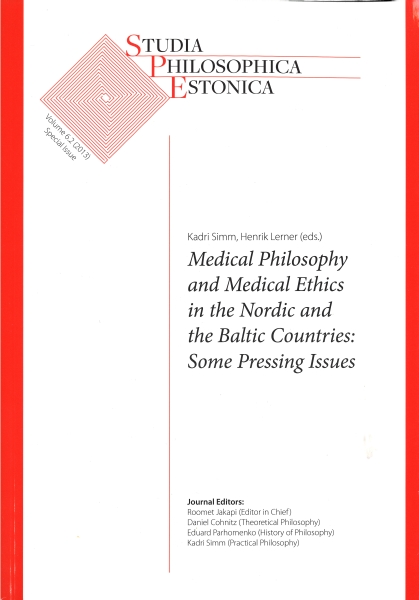Risk Communication in Assisted Reproduction in Latvia: From Private Experience to Ethical Issues
DOI:
https://doi.org/10.12697/spe.2013.6.2.06Keywords:
assisted reproduction, risk communication, patient/physician relationship, reproductive ethicsAbstract
The aim of this paper is to analyze the process of risk communication in the context of assisted reproduction in Latvia. The paper is based on a qualitative methodology and two types of data: media analysis and 30 semi-structured interviews (11 patients, 4 egg donors, 15 experts). The study explores a broad definition of risk communication and explores three types of risks: health, psychosocial, and moral. We ask (1), who is involved in risk communication, (2), how risks are discussed using different channels of communication, and (3), what ethical problems arise during this process. In the process of analysis, we identified four types of information channels and two strategies of risk communication used by patients, as well as several ethical problems. In our view, the analysis of risk communication practices is significant to improve patient/physician relationship, as well as better meet patients' needs for comprehensive risk information.
Downloads
References
Alaszewski, A. and Brown, P. (2007). Risk, uncertainty and knowledge, Health, Risk & Society 9: 1-10.
Alhakami, A. and Slovic, P. (1994). A psychological study of the inverse relationship between perceived risk and perceived benefit, Risk Analysis 14: 1085-1096.
Edwards, A. and Elwyn, G. (2006). Inside the black box of shared decision making – Distinguishing between the process of involvement and who makes the decision, Health Expectations 9: 307-320.
Eriksson, T., Nilstun, T. and Edwards, A. (2007). The ethics of risk communication in lifestyle interventions: Consequences of patient centredness, Health, Risk & Society 9: 19-36.
Franklin, S. (1997). Embodied Progress: A Cultural Account of Assisted Conception, Routledge, London.
Kaliarnta, S., Nihlen-Fahlquist, J. and Roeser, S. (2011). Emotions and ethical considerations of women undergoing IVF-treatments, HEC Forum 23: 281-293.
Keating, N. L., Gandhi, T. K., Orav, E. J., Bates, D. W. and Ayanian, J. Z. (2004). Patient characteristics and experiences associated with trust in specialist physicians, Archives of Internal Medicine 164: 1015-1020.
Krimsky, S. (2007). Risk communication in the internet age: The rise of disorganized skepticism, Environmental Hazards 7: 157-164.
Lampi, E. (2011). What do friends and the media tell us? How different information channels affect women’s risk perceptions of age-related female infertility, Journal of Risk Research 14: 365-380.
Land, J. A. and Evers, J. L. (2003). Risks and complications in assisted reproduction techniques: Report of an ESHRE consensus meeting, Human Reproduction 18: 455-457.
Laufer-Ukeles, P. (2011). Reproductive choices and informed consent: fetal interests, women’s identity, and relational autonomy, American Journal of Law & Medicine 37: 567-623.
Mezinska, S., Mileiko, I. and Putnina, A. (2012). Sharing responsibility in gamete donation: Balancing relations and new knowledge in Latvia, Medicine Studies 3: 185-196.
Miles, M. and Huberman, A. (1994). Qualitative Data Analysis, Sage Publications, Thousand Oaks.
Moller, D. (2011). Abortion and moral risk, Philosophy 86: 425-443.
O’Neill, O. (2002). Autonomy and Trust in Bioethics, Cambridge University Press, Cambridge.
Rauprich, O., Berns, E. and Vollmann, J. (2011). Information provision and decision-making in assisted reproduction treatment: Results from a survey in Germany, Human Reproduction 26: 2382-2391.
Reddy, M. U., Wapner, J. R., Rebar, R. W. and Tasca, R. (2007). Infertility, assisted reproductive technology, and adverse pregnancy outcomes: Executive summary of a National Institute of Child Health and Human Development workshop, Obstetrics & Gynecology 109: 967-977.
Rogers, W. A. (2002). Is there a moral duty for doctors to trust patients?, Journal of Medical Ethics 28: 77-80.
Sawyer, N. (2010). Sperm donor limits that control for the ‘relative’ risk associated with the use of open-identity donors, Human Reproduction 25: 1089-1096.
Sheard, C., Cox, S., Oates, M., Ndukwe, G. and Glazebrook, C. (2007). Impact of a multiple, IVF birth on post-partum mental health: A composite analysis, Human Reproduction 22: 2058-2065.
Silva, S. and Machado, H. (2010). Uncertainty, risks and ethics in unsuccessful invitro fertilisation treatment cycles, Health, Risk & Society 12:531-545.
Silva, S. and Machado, H. (2011). The construction of meaning by experts and would-be parents in assisted reproductive technology, Sociology of Health and Illness 33: 853-868.
Slovic, P. (1992). Perception of risk: Reflections on the psychometric paradigm, in S. Krimsky and D. Golding (eds), Social Theories of Risk, Praeger, Westport, pp. 117-152.
Thom, D. H., Wong, S. T., Guzman, D., Wu, A., Penko, J. and Miaskowski, C. (2011). Physician trust in the patient: Development and validation of a new measure, Annals of Family Medicine 9: 148-154.
Webster, A. (2002). Innovative health technologies and the social: Redefining health, medicine and the body, Current Sociology 50: 443-457.

